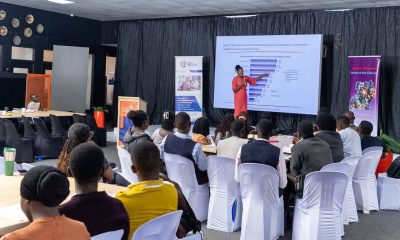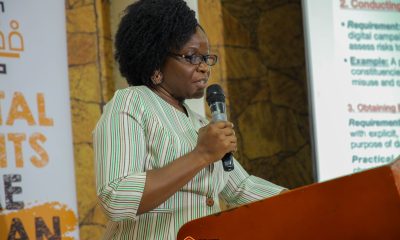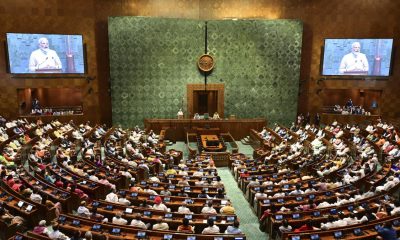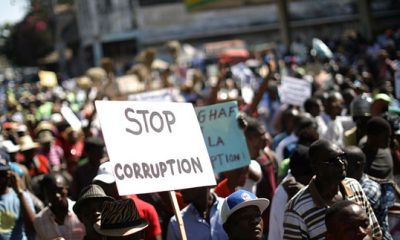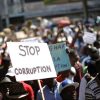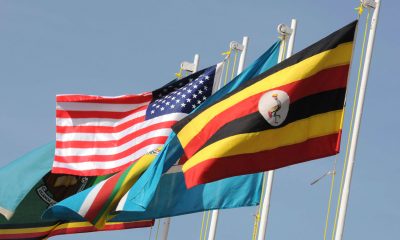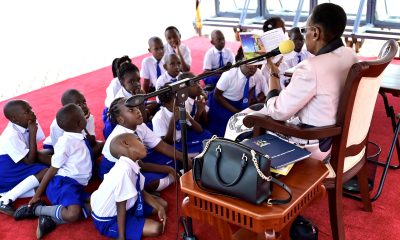Analysis
Rights body links S. Sudan, Uganda to cluster bomb use

UPDF Chief of Defence Force Gen. Katumba Wamala talking to his men in Sudan
In a statement released this week, 2014, near the town of Bor in an area not known to be contaminated by remnants prior to mid-December 2013.
According to HRW, the UN Mine Action Service (UNMAS) found the cluster munition remnants by a stretch of road 16 kilometers south of Bor, which is 190 kilometers north of Juba, the capital.
According to UNMAS, the site was contaminated with the remnants of up to eight RBK-250-275 cluster bombs and an unknown quantity of AO-1SCh bomblets or submunitions, which are dropped by fixed wing aircraft or helicopters. Uganda has deployed attack helicopters and other fighter planes in support of President Salva Kiir’s SPLA to fight rebels loyal to renegade Vice President Riek Machar.
“The young nation of South Sudan has enough problems without these horrific weapons, which kill and keep on killing long afterward,” said Steve Goose, arms division director at Human Rights Watch and chair of the Cluster Munition Coalition (CMC). “The governments involved should quickly find out who is behind this and make clear they will be held responsible.”
Since mid-December the town of Bor, the capital of Jonglei State, and the area around it have changed hands several times in clashes between government forces, the Sudan People’s Liberation Army (SPLA), and opposition forces loyal to former Vice President Riek Machar.
The Uganda People’s Defense Force (UPDF) has been supporting South Sudan’s government forces, including with air power.
However, during a new conference addressed by Uganda’s Minister of Foreign Affairs Sam Kuteesa, he denied that the UPDF have used cluster bombs in South Sudan.
UN Secretary-General Ban Ki-moon has condemned this use of cluster bombs in the South Sudan conflict, but has not indicated who the UN believes was responsible. South Sudanese and Ugandan forces possess the air power to deliver air dropped cluster munitions, such as the RBK-250-275 AO-1SCh cluster bomb, while the opposition forces are not believed to possess the means necessary to deliver these bombs.
HRM said: “The governments of South Sudan and Uganda should investigate the reported use of cluster bombs in South Sudan and make the results of those investigations public,”
It added: “The governments should enhance confidence in the independence and impartiality of the investigation by involving international experts, and by acting in cooperation with relevant international organizations such as UNMAS, the International Committee of the Red Cross, and others. All parties to the conflict should support and cooperate with the investigation.”
HRW called on all member countries party to the Convention on Cluster Munitions to pay serious attention to the new evidence of cluster bomb use in South Sudan.
South Sudan government forces use the Mi-17 Hip helicopter, which is capable of dropping cluster munitions, including the RBK-250-275 AO-1SCh cluster bomb. However, there were no reports or allegations of any production, export, use, or stockpiling of cluster munitions by the SPLA in the past when it functioned as a rebel armed force. In September 2011, shortly after it became an independent nation, South Sudan stated that it “is not a user or producer of cluster munitions,” and a government official told the CMC that South Sudan does not stockpile cluster munitions.
South Sudan’s defense minister, Gen. Kuol Manyang Juuk, has strongly denied that any cluster munitions have been used in the conflict, telling the Citizen newspaper: “These are total lies, it is not true, cluster bombs have never been used in the fighting.”
The commander of the Ugandan forces in South Sudan, Brig. Muhanga Kayanja, told Human Rights Watch that his forces had used helicopters to provide close aerial support to ground troops, but had not used cluster bombs, or any bombs, during the conflict.
On December 21, 2013, there were reports of Ugandan helicopter strikes near Bor at the same time as the South Sudanese government began a counter-attack on rebel positions. The Ugandan army’s chief of defense forces, Gen. Katumba Wamala, denied the claim of Ugandan involvement in the aerial bombardment but on January 10, 2014, Reuters quoted a Ugandan military officer saying, “In Bor our boys have been backing up the SPLA in the latest push to retake it… Yesterday [January 9] our MiGs conducted two bombings there.”
Though the initial decision to deploy Ugandan troops to South Sudan was not made in consultation with the Ugandan parliament, it nonetheless approved the deployment on January 15. Some members questioned the operational parameters and raised concerns about Uganda’s neutrality in the conflict. The Ugandan army spokesperson confirmed that two battalions, totalling at least 1,600 soldiers, are in South Sudan.
In 2007 a Ugandan government representative informed an international meeting that Uganda possessed a stockpile of cluster bombs that it would destroy. But in 2009, a senior military official said Uganda does not have any stockpiled cluster munitions, while in April 2012, a government official said, “Uganda has never manufactured, acquired, stockpiled, transferred, or used cluster munitions.”
Photographs and information, provided to Human Rights Watch by the United Nations Development Programme, of remnants cleared by mine action teams in northern Uganda near the then-Sudan border indicate that RBK-250-275 AO-1SCh cluster bombs were apparently used at some point in the years-long fighting between the rebel Lord’s Resistance Army (LRA) and the Ugandan military.
It is not clear who used the cluster munitions or precisely when or how many munitions were used. On several occasions, Uganda denied that its armed forces ever used cluster munitions and said the LRA was responsible.
South Sudan is not a party to the 2008 Convention on Cluster Munitions, which comprehensively bans cluster munitions, while the Republic of Uganda signed the convention on December 3, 2008, but has yet to ratify it. Worldwide, a total of 84 states are party to the convention, which came into force on August 1, 2010, while another 29 have signed but not yet ratified.
As a signatory, Uganda is not bound by all the convention’s provisions. However, the use of cluster munitions by a signatory can be judged a breach of its international obligations. Under article 18 of the Vienna Convention on the Law of Treaties, “A state is obliged to refrain from acts which would defeat the object and purpose of a treaty when… it has signed the treaty….” Clearly, new use of cluster munitions defeats the object and purpose of the treaty, Human Rights Watch said.
If South Sudanese forces are responsible for the use, Uganda could also be at risk of violating the Convention on Cluster Munitions by virtue of its close military cooperation, including joint combat operations, with those forces. Under article 1 of the Convention on Cluster Munitions, a state party may not “under any circumstance… assist, encourage or induce anyone to engage in any activity prohibited to a state party under this convention.”
Cluster munitions can be fired by rockets, mortars, and artillery, or dropped by aircraft. They explode in the air, sending dozens, even hundreds, of submunitions or “bomblets” over a wide area. These submunitions often fail to explode on initial impact, leaving duds that act like landmines and explode when handled.
Each RBK-250-275 AO-1SCh cluster bomb contains 150 AO-1SCh antipersonnel fragmentation bomblets. RBK cluster bombs were produced and exported by the former Soviet Union in significant quantities.
Since the Convention on Cluster Munitions became binding international law in 2010, three governments are confirmed to have used the weapons, all non-signatories: Syria, Libya, and Thailand. Syria has used cluster munitions extensively since 2012, including RBK-250-275 AO-1SCh cluster bombs, causing numerous civilian casualties.
Comments



